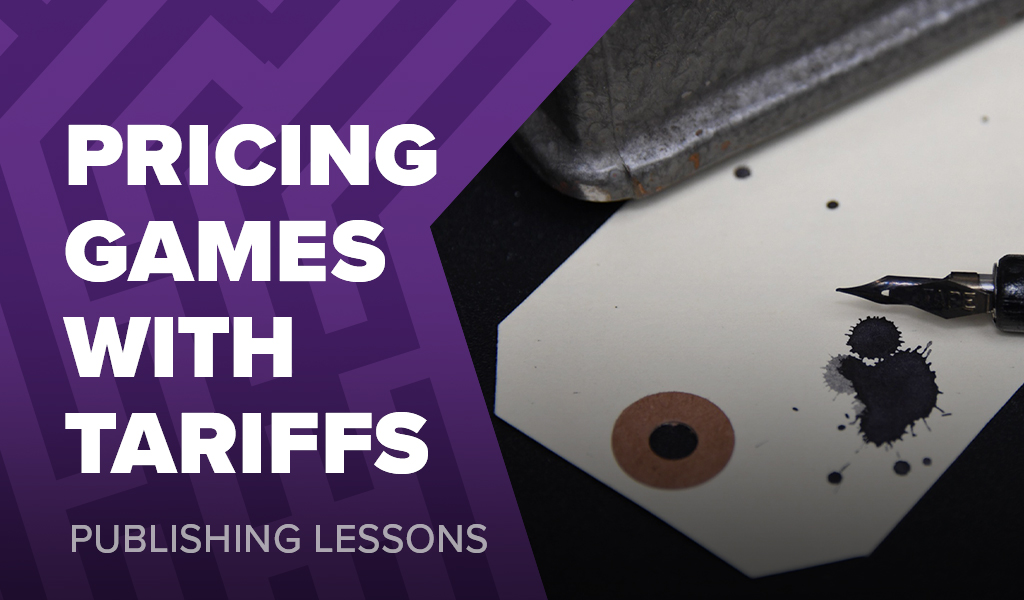Pricing games with tariffs

Last week, new tariffs were announced that impacted the board game industry—and I shared a publishing lesson asking the question: What can we do?
In that article, I suggested we needed to rethink how the financial model works between publishers, retailers, and distributors. We needed to change how pricing is calculated to accommodate these new tariffs.
One of the ideas I proposed was the pass-through method—a straightforward way to share the burden of tariffs across the supply chain. It was well received by many, and rightly challenged by others, with questions like: does it place too much strain on retailers?
Thanks to those challenges, I’ve had a chance to revisit the idea, refine it, and today I’d like to propose an updated version of the model—one that addresses every concern I’ve heard so far.
The Multiplier and Pass-Through Models
To explain where we’re at now, let’s quickly walk through the basics. For these examples I will be simplifying the numbers by ignoring royalties and other additional costs.
The Original Cost (No Tariffs)
Assuming a $10 cost to produce the game, we would calculate our MSRP using the standard 5× MSRP multiplier.
- Base cost: $10.00
- MSRP: $50.00
- Distributor pays: $20.00 (40% of MSRP – standard cost)
- Retailer pays: $25.00 (50% of MSRP – standard cost)
- Customer pays: $50.00
- Publisher receives: $20.00
This is the typical pre-tariff baseline model.
Traditional Multiplier Model (50% Tariff Included in Cost)
Assuming a $10 cost and 50% tariff ($5) added to the cost.
- Base cost: $15.00
- MSRP: $75.00
- Distributor pays: $30.00
- Retailer pays: $37.50
- Customer pays: $75.00
- Publisher receives: $30.00
This model maintains everyone’s percentage-based margin—but increases the final price significantly. Less games will be made and the consumer has to pay much more.
My Original Pass-Through Model
Assuming a $10 cost and 50% tariff ($5), passed evenly without multiplying.
- Base cost: $10.00
- Tariff cost: $5.00
- MSRP: $55.00 ($50 + $5)
- Distributor pays: $25.00 ($20 + $5)
- Retailer pays: $30.00 ($25 + $5)
- Customer pays: $55.00
- Publisher receives: $25.00
This model keeps the consumer price lower—but reduces the number of units retailers and distributors can afford to buy for the same budget, ultimately hurting their bottom line. It makes them take more risk while giving them no extra reward. Jamey Stegmaier goes into more detail about this here. A shop that once had 100 games in stock can now only have 90 games for the same investment, and are making no additional profit on those games to cover the 10 missing games.
A Revised Pass-Through Model
After reviewing all the concerns of the previous pass-through model, I created a list of goals for the new model.
Goals of the New Model
- Minimise MSRP increases for consumers
- Avoid adding extra burden to distributors
- Avoid adding extra burden to retailers
- Help publishers recover as much of the tariff cost as possible
- Work within existing systems—no new infrastructure or workflows required
That last point is key—we’re an industry built on a traditional model. Changing how everything is priced, tracked, and sold would be a logistical nightmare. So instead, the best approach is to keep the structure the same—but update how we calculate MSRP.
The New Calculation
Let’s take a game with a manufacturing cost of $10, and say a 50% tariff is added ($5).
Instead of adjusting every price downstream, we calculate MSRP using the following formula:
New MSRP formula = (Cost × 5) + (Tariff × 2)
For example:
- Base cost = $10
- Tariff = $5
- MSRP = (10 × 5) + (5 × 2) = $60
New Tariff Model Breakdown
- Base cost: $10.00
- Tariff cost: $5.00
- MSRP: $60.00 ((Cost × 5) + (Tariff × 2))
- Distributor pays: $24.00 (40% of MSRP)
- Retailer pays: $30.00 (50% of MSRP)
- Customer pays: $60.00
- Publisher receives: $24.00
You can see more examples of this model here.
In this model:
- Consumers pay $60, much lower than the $75 the current 5x multiplier would generate.
- Retailers and distributors maintain their existing margins.
- The publisher recovers 80% of the tariff cost.
- No system or workflow changes are required—just a new MSRP formula which can be reapplied as frequently as needed.
Why This Works
This model spreads the tariff cost in a balanced way without punishing any part of the supply chain.
- Retailers and distributors still pay and make their traditional percentages
- Publishers absorb a small portion of the tariff (20%), but avoid extreme MSRP hikes
- Consumers pay more, but in a controlled and justifiable way
- No renegotiations or system changes are needed
- The calculation is flexible and works for different price point games and different levels of tariffs.
If you’re a publisher who can’t afford to absorb a any loss on a game, you can adjust the multiplier on the tariff portion to 2.5x, but I think 2× hits the right balance.
Final Thoughts
I believe this new model addresses all the concerns I’ve seen so far. It keeps things simple, avoids putting too much pressure on any one part of the chain, and helps publishers recover most of the costs without forcing prices through the roof.
It’s not perfect—but it’s flexible, practical, and works within the systems we already have.
Let me know what you think.
Frank West
Frank West is a gamer and designer based in Bristol, UK. He published his first board game, The City of Kings, in 2018 and now works on other games and organising events in the local area. His goal? To design and publish games focusing on immersive themes, fun mechanics and beautiful components. If you have any questions or would just like a chat, feel free to get in touch at any time!

